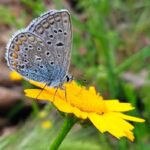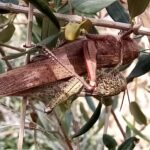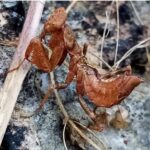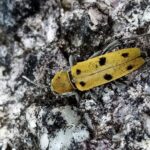“Gli animali del Parco”
From a naturalistic perspective, the Monte Pisano is considered an isolated plateau, surrounded by a largely urbanized plain, where many species of animals find refuge. Most of these species also frequent the Park.
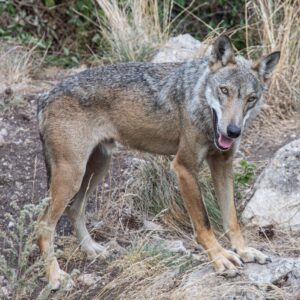 THE RETURN OF THE WOLF
THE RETURN OF THE WOLF
The Park, like the rest of the Monte Pisano, is inhabited by at least one family of Apennine wolves (Canis lupus italicus Altobello, 1921) (photo by Paola Fazzi). The wolf is a protected species, a top predator, crucial for the balance of our natural ecosystems, and it is once again spreading throughout the Italian territory. It mainly feeds on ungulates, and its preferred prey on the Monte are wild boars. In the Park, you can find its tracks and droppings (scat).
LORDS OF THE PARK
Wild boars (Sus scrofa Linnaeus, 1758) are the undisputed lords of the Park and, in general, the entire Monte Pisano, given their abundance across the territory. Their frequent presence in the Park is evidenced by the numerous patches of upturned soil with their snouts in search of food, their tracks, and their droppings. They are omnivorous animals that feed on tubers, bulbs, seeds, worms, snakes, lizards, and other small animals.
THE SMALLEST MAMMAL IN ITALY
The upper part of the Park is also frequented by some species of shrews (family Soricidae, order Eulipotyphla), including the Etruscan shrew (Suncus etruscus (Savi, 1822)), which, at just 4.5 cm in length (excluding tail), is considered the smallest mammal in Italy! Shrews are similar to mice (order Rodentia), but they are mainly distinguished by their elongated snout. They feed on insects and other invertebrates, are agile and fast, live on the ground, and rarely climb.
FLYING MAMMALS
During summer nights, bats (order Chiroptera) flutter over the Park in search of insects, including mosquitoes. All Italian bats are protected species, have nocturnal habits, and are insectivores. They hibernate during winter, forming large colonies in caves, cellars, attics, abandoned buildings, or even tree cavities.
Other mammals that frequently inhabit the Park include: the hedgehog (Erinaceus europaeus Linnaeus, 1758), the badger (Meles meles (Linnaeus, 1758)), the fox (Vulpes vulpes (Linnaeus, 1758)), the beech marten (Martes foina (Erxleben, 1777)), the weasel (Mustela nivalis Linnaeus, 1766), the crested porcupine (Hystrix cristata Linnaeus, 1758), and wild mice (genus Apodemus).
NOT A PARK FOR AMPHIBIANS
The too dry environment of the Park is not suitable for amphibians; only a few common toads (Bufo bufo (Linnaeus, 1758)) frequent the Park on the damper nights in search of prey and perhaps find refuge here during the winter months. However, the Italian red frog (Rana italica Dubois, 1987) has been observed in the stream next to the Park.
In addition to bats, many species of birds soar over the Park in search of food. The swallow (Hirundo rustica Linnaeus, 1758), the swift (Apus apus (Linnaeus, 1758)), and the house martin (Delichon urbicum (Linnaeus, 1758)) catch insects in flight. The hoopoe (Upupa epos Linnaeus, 1758) prefers to feed on insects and lizards on the ground. These are four common species of skilled migratory fliers that arrive on Monte Pisano at the beginning of spring to nest and depart at the end of summer to hibernate in Africa. Other common bird species in the Park, and generally in all open spaces of Monte, include the magpie (Pica pica (Linnaeus, 1758)), the wood pigeon (Columba palumbus Linnaeus, 1758), the turtledoves (genus Streptopelia), the blackbird (Turdus merula Linnaeus, 1758), sparrows (genus Passer), the great tit (Parus major Linnaeus, 1758), and the wagtails (genus Motacilla).
L’ambiente troppo secco del Parco non è idoneo per gli anfibi; solo qualche rospo comune (Bufo bufo (Linnaeus, 1758)) frequenta il Parco nelle notti più umide
alla ricerca di prede e forse vi trova rifugio nei mesi invernali; però nel ruscello
di fianco al Parco è stata osservata la rana rossa italiana (Rana italica Dubois, 1987).
SNAKE EAGLE
Various diurnal and nocturnal raptors hunt their prey in the Park, including the largest, the short-toed snake eagle (Circaetus gallicus (Gmelin, 1788)), with a wingspan of almost 2 meters. This migratory species is represented on Monte Pisano by at least one nesting pair. It is called short-toed snake eagle because of its short toes in comparison with the other species of the genus and because it primarily feeds on reptiles, especially snakes. In ìtalian it’s called “biancone” because of its distinctive light-colored ventral plumage.
A THREAT TO THE OLIVE GROVES
Lastly, starlings (Sturnus vulgaris Linnaeus, 1758) also come to feed in the Park. These highly gregarious birds form roosts with thousands of individuals and often fly in large flocks that can adopt group defenses against birds of prey. They are omnivores and are fond of olives; they can hold three at a time: one in the beak and two in their feet. They drop the ones in their feet, eat the one in their beak, then gather and consume the other two!
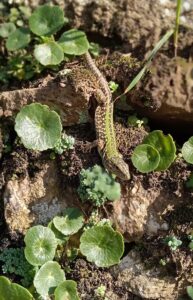 THE SMALL INHABITANTS OF WALLS AND PILES
THE SMALL INHABITANTS OF WALLS AND PILES
The dry stone walls and piles of burnt logs in the Park are ideal microenvironments for the common wall gecko (Tarentola mauritanica (Linnaeus, 1758)) and the Italian wall lizard (Podarcis siculus (Rafinesque-Schmaltz, 1810)) (photo by Roberta Sabelli), and to a lesser extent, the common wall lizard (Podarcis muralis (Laurenti, 1768)). These creatures find refuge in these places to rest during the hottest and coldest hours, hibernate during the winter season, and lay their eggs. These microenvironments are also inhabited by various species of invertebrates that thrive in dark and damp corners, such as the house centipede (Scutigera coleoptrata (Linnaeus, 1758)), the scorpion (Euscorpius italicus Herbst, 1800), woodlice (genus Armadillidium), and the pill millipede (Glomeris marginata Villers, 1789). The house centipede and scorpion are venomous but are shy and non-aggressive. They assume a defensive position when threatened and only attack when touched. Moreover, their venom does not pose a serious threat to humans.
Three other reptile species also frequent the Park in search of prey: the green lizard (Lacerta bilineata Daudin, 1802), the smooth snake (Hierophis viridiflavus (Lacépède, 1789)), and the Aesculapian snake (Zamenis longissimus (Laurenti, 1768)). The smooth snake and Aesculapian snake are two non-venomous snake species but are rather aggressive and may bite if disturbed.
AN IMPORTANT ABSENCE
Throughout the territory of Monte Pisano, the asp viper (Vipera aspis (Linnaeus, 1758)), a venomous snake present in the surrounding plains, is absent.
A MOLLUSK IN THE SUN
Unlike common snails that prefer humid and shady environments, Solatopupa juliana (Issel, 1866) is a small gastropod mollusk adapted to arid environments that can be found attached to rocks or dry stone walls in the Park.
UNDERGROUND ALLIES
The 2018 fire damaged the soil of the Park, which slowly regained its fertility, thanks in part to the contribution of earthworms (genus Lumbricus), annelids that live and feed within the soil. With their activity, they mix and oxygenate the soil, contributing to humus formation.
POLLINATING INSECTS
A significant portion of the Park’s meadow has been left untamed, without being cut, in order to protect plant and animal biodiversity, particularly pollinating insects that find the meadow environment ideal for shelter, nourishment, and reproduction. The preservation of wild meadows aligns with the 2021 Biodiversity Directive of the Ministry of Ecological Transition, which identifies insect protection as a key action for safeguarding and restoring biodiversity and ensuring the maintenance of ecosystem services. Thus, it’s easy to observe many pollinators on the flowers of the Park, including bees, hoverflies, and colorful butterflies such as the swallowtail butterfly (Papilio machaon Linnaeus, 1758), the peacock butterfly (Inachis io (Linnaeus, 1758)), the red admiral (Vanessa atalanta (Linnaeus, 1758)), and the common blue (Polyommatus icarus (Rottemburg, 1775)).
In addition to pollinators, the Park is inhabited by countless other insects: crickets; grasshoppers; ants; mantises, both the common praying mantis (Mantis religiosa (Linnaeus, 1758)) and the smaller and rarer Spallanzani’s mantis (Ameles spallanzania (Rossi, 1792)); various species of bugs and froghoppers (Order Hemiptera); many species of beetles, including ladybugs (family Coccinellidae), longhorn beetles (family Cerambicidae), including the splendid Chlorophorus glabromaculatus (Goeze, 1777), scarab beetles (family Scarabaeidae), including the brilliant rose chafer (Cetonia aurata (Linnaeus, 1758)), and fireflies (family Lampyridae) that light up the entire Park on summer nights. Lastly, the Park is characterized by the presence of stick insects (genus Bacillus). Stick insects are a remarkable example of cryptic mimicry in both appearance and behavior: they have a slender and elongated body and move slowly among the grass and shrubs, resembling twigs swaying in the wind.
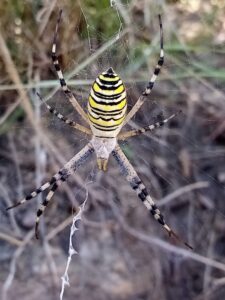 INSECT HUNTERS
INSECT HUNTERS
The abundance of insects naturally attracts their predators, including spiders. Among the most striking species is the wasp spider (Argiope bruennichi (Scopoli, 1772)) (photo by Pietro Curzio), named for its large abdomen with yellow and black stripes. It weaves large webs among the vegetation to capture prey. Other spiders, such as crab spiders (family Thomisidae), do not spin webs but rather lie in wait, camouflaged on flowers, for pollinating insects.
BEWARE OF TICKS!
Ticks, small blood-feeding mites (class Arachnida), can also be present in the Park during spring and summer. They attach themselves to various animals, including humans, and can transmit infectious diseases.
Instructions for tick removal
Further Reading: la fauna del Monte Pisano.
Bibliography
S. Sorbi & P. Scaglia (2018) “I tesori del Monte Pisano I. Gli Animali” Pacini Editore, Pisa.

